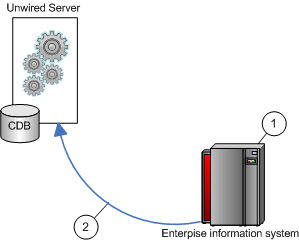Data change notification (DCN) provides an HTTP interface by which enterprise information system (EIS) changes can immediately be propagated to Unwired Server.
All DCN commands support both GET and POST methods. The EIS developer creates and sends a DCN to Unwired Server through HTTP GET or POST operations. The portion of the DCN command parameters that come after http://host:port/onepage/servlet/UWPServlet? can all be in POST, or any var=name can be in either the URL (GET) or in the POST. The authenticate.password parameter is an especially good candidate for including in the POST method, as well as any sensitive data provided for attributes and parameters because the HTTP POST method is more secure than HTTP GET methods.
Note: Enter the HTTP request on a single line.
You can use DCN with or without payload:
- To instruct Unwired Server to invoke an operation without payload, the DCN instructs Unwired Server to do something, based on the Unwired Server configuration or MBO settings as shown here. DCN without payload
- (1) EIS data changes, which triggers the DCN.
- (2) The DCN issues instructions to Unwired Server.
- (3) Unwired Server performs the DCN task, for example, invalidating and refreshing an MBO.
- In the method shown here, the Unwired Server cache is udpated directly. The actual data (payload) is applied to the cache, through either an :upsert (update or insert) or a :delete operation. DCN with payload
- (1) EIS data changes, which triggers the DCN.
- (2) The DCN applies data changes, for example deleting a data row, directly to the cache (CDB).
Be familiar with the EIS data source from which the DCN is issued. DCNs can be created and sent based on:
- Database triggers
- EIS system events
- External integration processes

